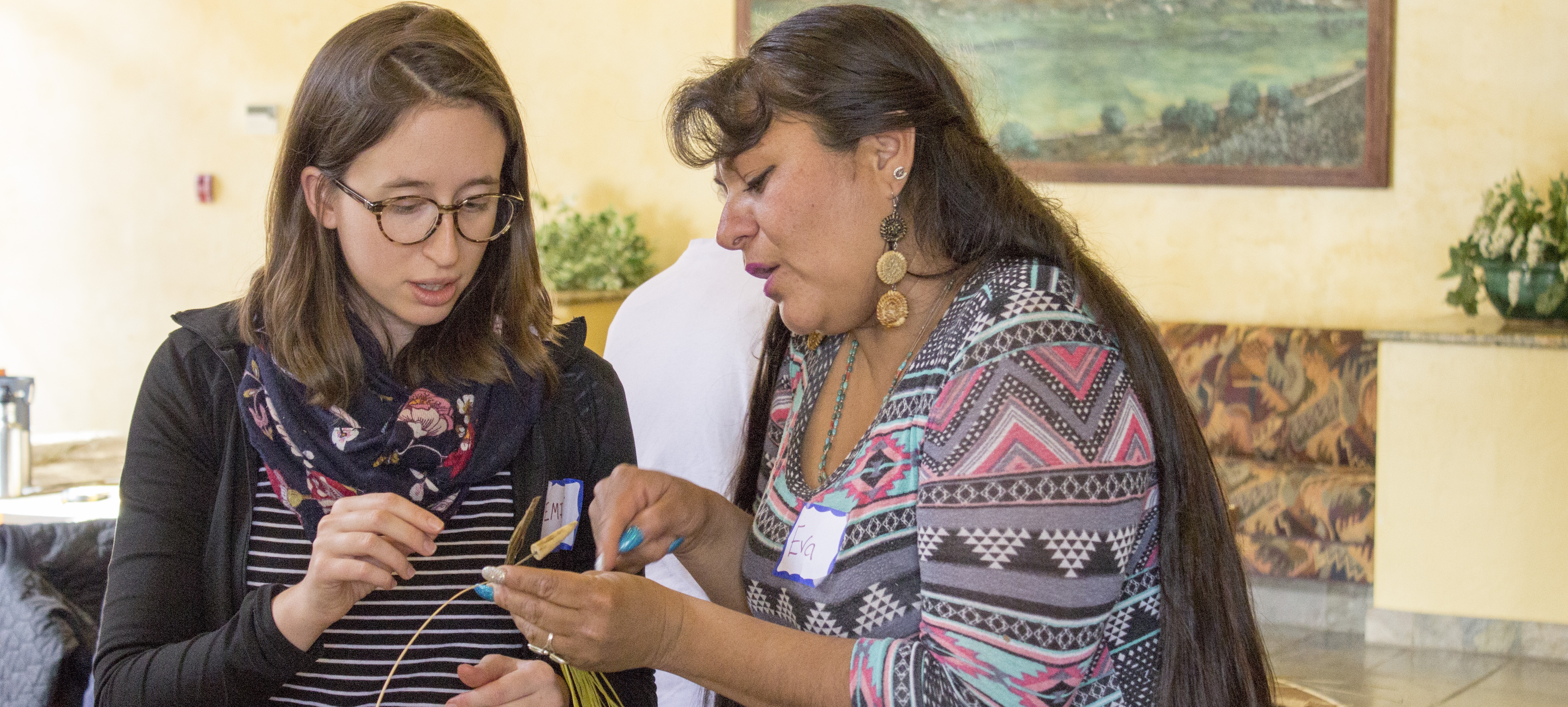Guidelines in Action: UCLA/Getty Conservation Program

UCLA/Getty student Emily Rezes (’20) receiving instruction from Kumeyaay weaver Eva Salazar at the Barona Cultural Center and Museum, San Diego, California. Photo courtesy of Ellen Pearlstein
In 2017 the Indian Arts Research Center at the School for Advanced Research first published a new resource known as the Guidelines for Collaboration. Drawing from decades of case studies and three years of focused work with Native and non-Native museum professionals, cultural leaders, and artists, the Guidelines provide a series of methods for how museums and source communities can work together across two-way learning opportunities. Today the Guidelines are used in classrooms, museums, cultural institutions, tribal communities, and elsewhere.
Guidelines in Action is a series of guest posts highlighting stories from the field.
Guest post by Ellen Pearlstein, Professor of Information Studies and the UCLA/Getty Program in the Conservation of Archaeological and Ethnographic Materials
The Guidelines teach young conservators about how emotional and surprising it can be to discover one’s own heritage in unexpected places and how harsh the lab environment can be to community members.

Ellen Pearlstein. Photo courtesy of UCLA/Getty Program in the Conservation of Archaeological and Ethnographic Materials
As a conservation educator I am always inspired by, and assign to students, the Community+Museums and Museums+Community Guidelines. The mission statement for the UCLA/Getty Program in the Conservation of Archaeological and Ethnographic Materials includes “the importance of working within a cultural context and as part of an interdisciplinary team,” and furthermore, “the program emphasizes the collaborative nature of conservation.” Understanding these concepts, and the ways in which working with communities improves conservation work and heals relationships are all thoughtfully mapped out in the Guidelines.

UCLA/Getty student Skyler Jenkins (’20) enjoying help received from Kumeyaay weaver Eva Salazar at the Barona Cultural Center and Museum, San Diego, California. Photo courtesy of Ellen Pearlstein
In my instruction at UCLA/Getty I incorporate Guidelines principles by including Native instructors in the teaching practice, and by working with tribal cultural centers and museums in a long-term collaboration to build relationships and illustrate first-person representation to students. This instruction inspires respect and hospitality in young conservators and moves students away from jargon in reporting practices. By including tribal members among the experts consulted, conservation students are able to learn how baskets are made, how they are part of a network of relationships, and how materials have not only mechanical and chemical properties, but also traditional values. They learn about the high regard in which the community holds expert weavers who are responsible for revitalizing and sharing important traditions.
The Guidelines teach young conservators about how emotional and surprising it can be to discover one’s own heritage in unexpected places and how harsh the lab environment can be to community members. Using the Guidelines, I have assigned conservation students to prepare a potluck meal to welcome community guests and used students’ visual, analytical, and documentation skills to answer questions important to the community. While students are familiar with proposing conservation work to curators, with whom we hope we are on equal footing within museums, my instruction promotes proposing conservation to tribal councils, who respect the work conservation provides but with whom students are not on equal footing. There is an important humility that is taught to young conservators working in this way.
The Guidelines contribute to evaluations like the following:
“I felt this class was extremely important in order to improve our skills working with communities and specifically with Native communities.”
“I learned a lot from this course. It was particularly rewarding to engage with Barona community members throughout the quarter. This class should definitely continue to be offered, as it provides an important educational experience for emerging conservators.”
“Strengths: Valuable interaction with Native community leading to good understanding of basketry materials and techniques, as well as collaborative decision making.”
Learn more about the IARC Guidelines for Collaboration here.
SIGN UP FOR THE SAR MONTHLY NEWSLETTER and stay up to date on our projects and programs.